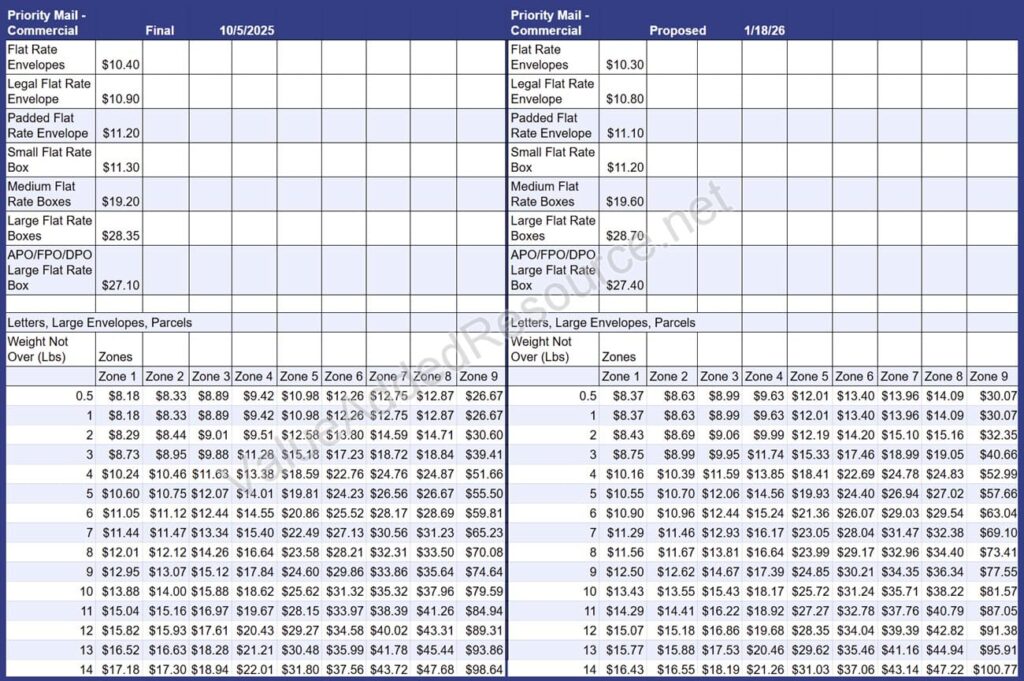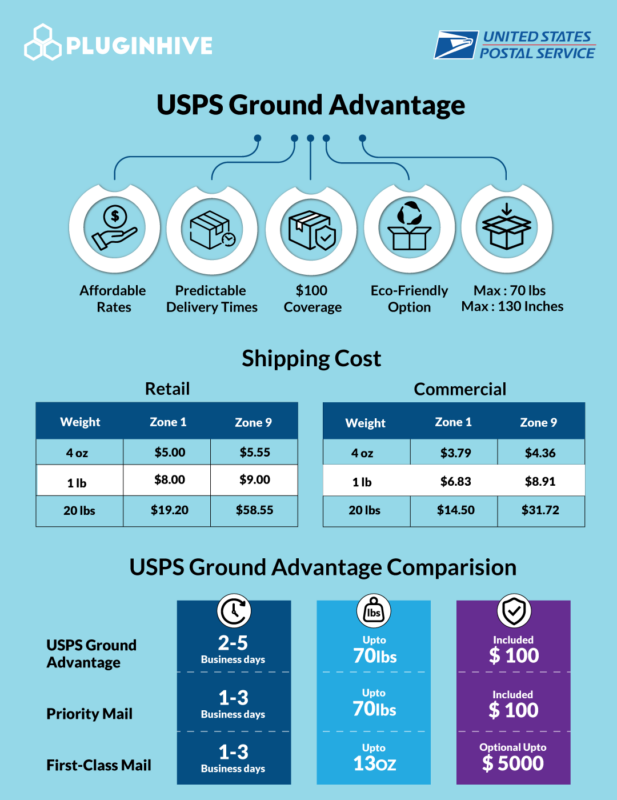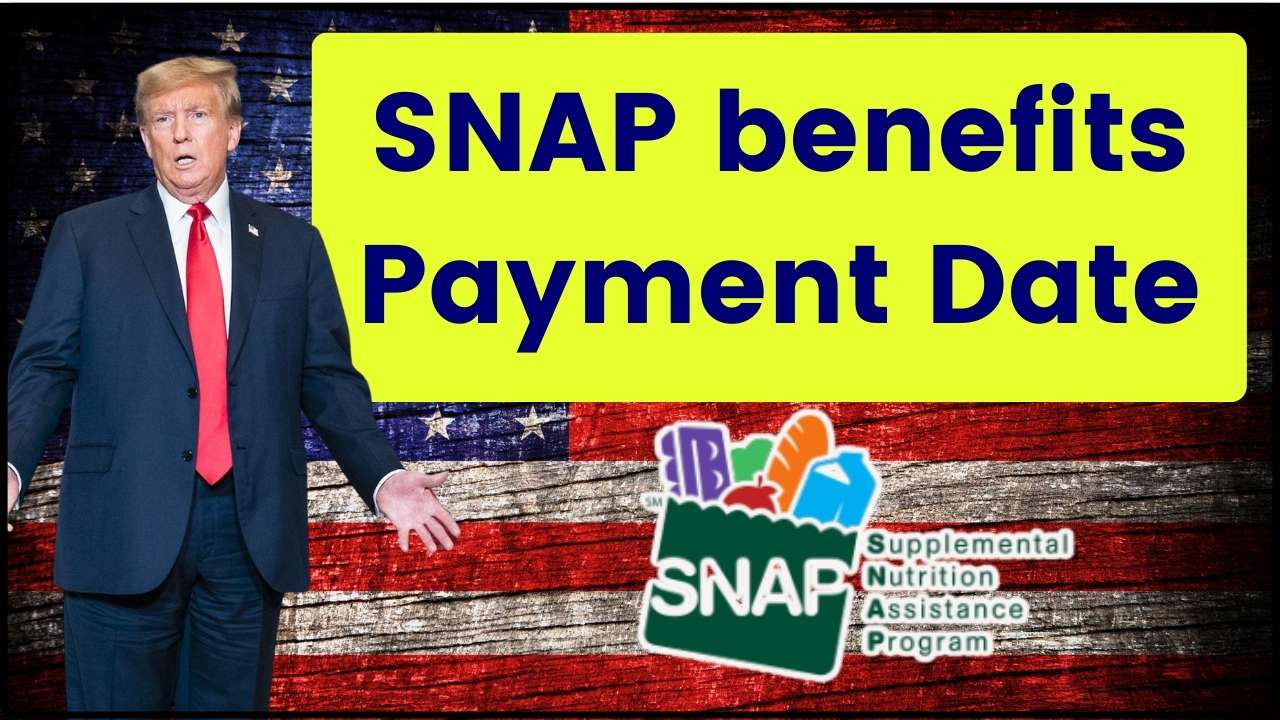
USPS Is Raising Prices Again: Starting January 18, 2026, the United States Postal Service (USPS) is rolling out price increases for most of its shipping services. If you’ve ever shipped a package—whether it’s a birthday gift, a business order, or a holiday present—you’ll want to know what’s changing and how it’ll affect your wallet. The price hikes range from 5.1% to 7.8% depending on the service, and every size box will see a bump, except for First-Class Mail stamps, which are staying put
USPS Is Raising Prices Again
USPS is raising shipping prices in 2026, with most box sizes seeing increases between 5.1% and 7.8%. While First-Class Mail stamps will stay the same, businesses and individuals alike should plan ahead to manage the extra costs. By understanding the changes and using available tools, you can keep your shipping expenses under control and avoid surprises.
| Service | Price Increase | Example (2025 → 2026) |
|---|---|---|
| Priority Mail | 6.6% | $21.95 → $22.95 (Medium Box) |
| Priority Mail Express | 5.1% | $33.25 → $34.95 (Large Envelope) |
| USPS Ground Advantage | 7.8% | $12.60 → $13.58 (Small Box) |
| Parcel Select | 6.0% | $10.45 → $11.08 (1 lb package) |
| First-Class Mail Stamps | 0% | $0.66 → $0.66 |
Why USPS Is Raising Prices Again?
The Postal Service isn’t just raising prices for kicks. These increases are part of a larger plan to keep USPS financially stable and competitive in a world where shipping is more in demand than ever. The changes support USPS’s modernization efforts, helping it deliver mail and packages reliably across the country, six days a week. The new rates are also meant to cover rising costs like fuel, labor, and equipment, which have been squeezing the agency’s budget.
The Impact of Inflation and Modernization
Over the past decade, USPS has faced mounting pressure from inflation, increased operational expenses, and the need to modernize its technology and infrastructure. The Postal Service has invested heavily in automation, new delivery vehicles, and digital platforms to improve efficiency and customer service. These investments are critical for USPS to keep up with the rapid growth of e-commerce and the changing needs of consumers and businesses. However, they come with a price tag, and the 2026 rate increases are a direct reflection of these ongoing efforts.
Seasonal Adjustments and Temporary Changes
In addition to the permanent increases, USPS has also implemented temporary price changes for peak seasons, such as the 2025 holiday shipping period. For example, during the holiday season, rates for Priority Mail and USPS Ground Advantage increased by $0.40 to $3.00, depending on the zone and package weight. These temporary adjustments help USPS manage the extra handling costs and ensure smooth operations during high-demand periods. The 2026 increases will build on these seasonal changes, making the new rates more sustainable year-round.
What’s Changing and What’s Not?
What’s Going Up
- Priority Mail: This is the go-to for most folks shipping packages. Expect a 6.6% bump for boxes of all sizes. For example, a medium Priority Mail box will go from $21.95 to $22.95.
- Priority Mail Express: If you need fast, guaranteed delivery, you’ll pay 5.1% more. A large flat-rate envelope will jump from $33.25 to about $34.95.
- USPS Ground Advantage: This budget-friendly option is getting a 7.8% hike. A small box will cost about $13.58 instead of $12.60.
- Parcel Select: Businesses and bulk shippers will see a 6.0% increase. A 1 lb package could go from $10.45 to $11.08.
What’s Staying the Same
- First-Class Mail Stamps: The price of a regular stamp won’t budge. You’ll still pay 66 cents for a First-Class letter.
- APO/FPO/DPO Large Flat Rate Box: Military families and those shipping to overseas bases will see no change for this box.
- Post Office Box Rentals: Fees for renting a PO Box will remain the same or even decrease in some cases.
A Look Back: USPS Rate Increase History
USPS has a long history of adjusting rates to keep up with inflation and operational costs. Since the beginning of the 21st century, postage stamp prices have increased 16 times, compared to only 17 times in the entire 20th century. The most recent increase in July 2025 raised the cost of a Forever stamp to 78 cents, up from 73 cents. The Postal Reorganization Act of 1970 gave USPS more autonomy but also led to more frequent rate changes, typically every 2-3 years. The Postal Accountability and Enhancement Act of 2006 further limited rate increases to the rate of inflation, but also required USPS to pre-fund retiree health benefits, adding to financial pressure. These factors have made regular price adjustments necessary for the agency’s survival.

Historical Context and Trends
Over the years, USPS has faced challenges from technological advancements, changes in consumer behavior, and increased competition from private carriers. The rise of e-commerce has led to a surge in package volumes, putting additional strain on the postal network. To adapt, USPS has introduced new services like Priority Mail Cubic, which charges based on a package’s outer dimensions rather than its weight, and has expanded its digital offerings to improve customer experience.
USPS vs. FedEx vs. UPS: What’s the Best Option?
When it comes to shipping, USPS, FedEx, and UPS each have their strengths. For small packages under 20 lbs, USPS Priority Mail is usually the cheapest and most reliable. FedEx and UPS are better for larger, heavier packages and offer more robust tracking and guaranteed delivery times. For urgent deliveries, FedEx and UPS offer overnight and 2-day options, though these services come with higher costs. If you’re shipping to a PO Box or military address, USPS is your only option.
| Carrier | Best For | Average Cost (Small Package) | Key Features |
|---|---|---|---|
| USPS | Small packages, PO Boxes | $7.94 (Priority Mail) | Affordable, wide coverage |
| UPS | Large/heavy packages | $83.12 (65 lb, Ground) | Reliable, strong tracking |
| FedEx | Urgent, valuable items | $16.95 (Express Saver) | Fast, specialized services |
Carrier Comparison in Detail
- USPS: Known for affordability and accessibility, USPS is the best choice for small, lightweight packages and PO Box deliveries. It offers special “cubic” rates for packages that fit within certain dimensions, making it a favorite among e-commerce businesses.
- UPS: UPS excels in reliability and is the go-to for large, heavy packages and high-value items. It offers a wide range of express services and has a strong reputation for customer service.
- FedEx: FedEx specializes in express and overnight shipping, making it ideal for time-sensitive deliveries and business-to-business shipments. It also offers specialized services for perishable and temperature-controlled goods.
How Small Businesses Are Affected?
Small businesses, especially those in e-commerce, are feeling the pinch from rising shipping costs. Many are having to adjust their budgets, pass on costs to customers, or look for ways to optimize shipping strategies. Some businesses are switching to a mix of carriers to find the best rates, while others are exploring flat-rate shipping options or offering fewer expedited choices. For online retailers, even a small increase can add up over hundreds or thousands of orders, so it’s crucial to stay informed and flexible.
Strategies for Small Businesses
- Negotiate with Carriers: High-volume shippers can often negotiate better rates with USPS, UPS, and FedEx.
- Use Third-Party Logistics (3PLs): Partnering with a 3PL like ShipBob can provide access to discounted rates and automated multi-carrier selection, helping businesses save money and improve customer service.
- Optimize Packaging: Use the smallest box that fits your items to avoid dimensional weight charges and consider poly mailers for lightweight, non-fragile items
- Offer Multiple Shipping Options: Provide customers with a range of shipping speeds and costs to meet their needs and preferences.
Future Outlook for USPS Rates
Experts expect USPS to continue raising rates in the coming years as operational costs and inflation persist. The Postal Regulatory Commission oversees these changes, ensuring they are fair and necessary for USPS’s financial health. For consumers and businesses, the key is to stay informed, compare options, and plan ahead to manage costs effectively.

Long-Term Trends
- Increased Automation: USPS is investing in automation to improve efficiency and reduce costs.
- Digital Transformation: The agency is expanding its digital offerings to enhance customer experience and streamline operations.
- Sustainability Initiatives: USPS is also focusing on sustainability, with plans to transition to electric delivery vehicles and reduce its carbon footprint.
SNAP benefits Payment Date in December 2025; Check Payment Amount & State Wise Eligibility
Social Security Benefits in December 2025; Check SSI and SSDI deposit schedule










